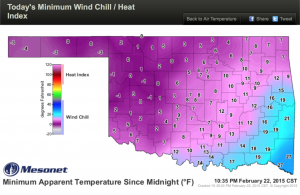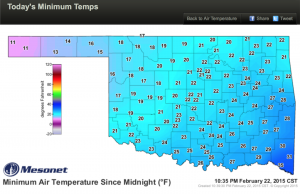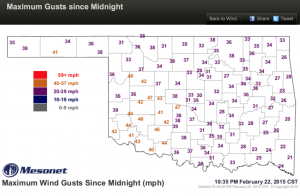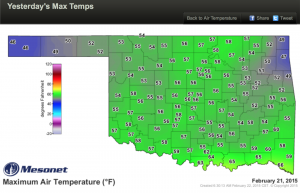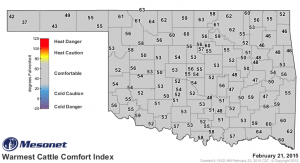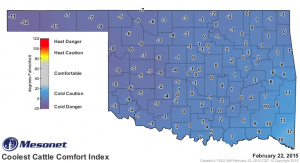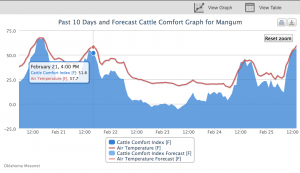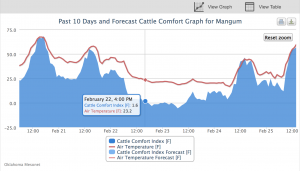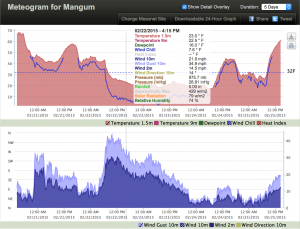Cold temperatures lose there bite when wind speeds are low. Even temperatures down near freezing can feel balmy when the wind is still.
The real chill comes when the wind drives the cold through your clothes. With a biting wind, cold temperatures can chill you clear down to the bone. Consider Sunday, February 22, 2015 across the state of Oklahoma. The coldest wind chills that day were single digit numbers. On the Oklahoma Mesonet, wind chill and heat index are reported on the Apparent Temperture map. This provides a single map that can show either or both heat and cold stress.
Checking on the minimum air temperatures for that day shows that for many of those single digit wind chill locations temperatures were in the upper teens to low twenties.
Those single digit wind chills came from brisk winds that added to the low air temperatures.
The kicker in this cold event was that it followed a mild day, Saturday, February 21st. Maximum air temperatures Saturday afternoon varied from the mid-fifties to mid-sixties for much of the state.
Cold and heat levels that cattle feel are different than those for humans. To monitor cold and heat levels that cattle feel, we can turn to the Mesonet Cattle Comfort Advisor. There was a larger range in Cattle Comfort Index values across the state than there was in air temperature, due to the variation in sunlight. Cattle Comfort Index values are calculated from air temperature adjusted by sunlight, humidity, and wind speed. Index values are reported in degrees fahrenheit.
On Sunday, colder temps and higher winds pushed the Mesonet Cattle Comfort Advisor values into the negative range for the western half of the state and just above zero for many other locations.
For Mangum, in southwest Oklahoma, it turned out to be a change of 57 degrees from Saturday to Sunday. Just when the cattle were getting comfortable, they woke up to face a much colder day.
Graphing the Cattle Comfort Index and air temperature over time lets us see the rapid change for a single Mesonet site. At 4:00 PM on Saturday, February 21, the Mangum air temperature was 57.7 degrees and the Cattle Comfort was 51.6 degrees.
Twenty-four hours later on Sunday at 4:00 PM, the Mangum air temperature was 23.2 degrees and the Cattle Comfort Index had slid down to 1.6 degrees.
If we look at graphs for Mangum air temperature and wind chill from the same days, we get a feel of how air temperature and wind interact to give a wind chill. On Saturday, February 21st, at 4:15 PM, the air temperature at 1.5m was 56.8 degrees fahrenheit. The wind was 12.8 miles per hour. The temperature was above 50 degrees, the base temperature for wind chill.
Twenty-four hours later, at 4:15 PM on Sunday, the air temperature was 23.0 degrees and the wind blowing at 21.9 miles per hour. That dropped the human wind chill down to 7.6 degrees. That was a 49.2 degree drop in wind chill in twenty-four hours.
Saturday working outside was a treat. Sunday was just down right brutal. A perfect day to be inside if you were a person and a day for cattle to shimmy up to a windbreak.
